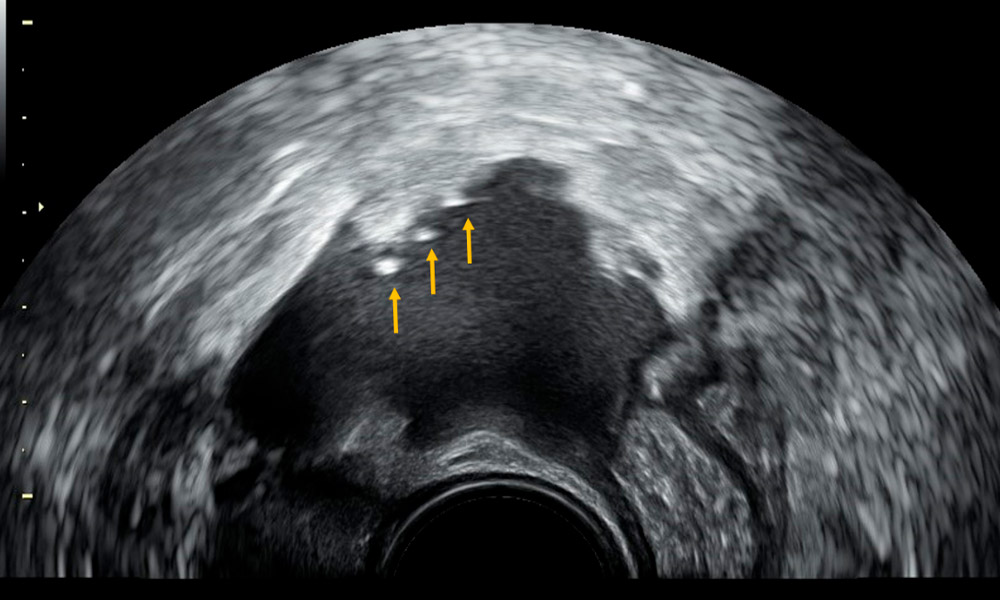
The current prevalence of superficial endometriosis is poorly understood, although it is the most common subtype of endometriosis. Moreover, its diagnosis is difficult, as the appearance and characteristics of the lesions it causes are not well known at the ultrasound level, so it is often necessary to perform a laparoscopy or histological study to confirm the diagnosis. This is why a group of researchers from several countries, including Dr Mª Angela Pascual and Dr Betlem Graupera, the Director of R&D and the Head of our Gynaecological Diagnostic Imaging Service (DGI), have carried out a prospective study to examine the lesions associated with this condition on the basis of images obtained by transvaginal ultrasound and to expand our current knowledge of their appearance and characteristics.
The study was conducted on 52 women with clinically suspected pelvic endometriosis who underwent preoperative transvaginal ultrasound and received a confirmed diagnosis of superficial endometriosis by laparoscopy. Women with deep endometriosis detected by ultrasound or laparoscopy were not included in the study.
The researchers observed that lesions caused by superficial endometriosis may appear as solitary lesions, multiple separate lesions and cluster lesions. They may also present associated hypoechogenic tissue, hyperechoic foci and/or velamentous adhesions). The lesion may be convex, protruding from the peritoneal surface, or may appear as a concave defect in the peritoneum. In general, most of the lesions had several of these characteristics.
The conclusion of the paper is that transvaginal ultrasound can be useful in diagnosing superficial endometriosis, and that the lesions have different ultrasound characteristics that can be described.
Reference article:
Superficial Endometriosis at Ultrasound Examination-A Diagnostic Criteria Proposal
Marcelo Pedrassani, Stefano Guerriero, María Ángela Pascual, Silvia Ajossa, Betlem Graupera, Mariachiara Pagliuca, Sérgio Podgaec, Esdras Camargos, Ygor Vieira de Oliveira, Juan Luis Alcázar
Diagnostics (Basel). 2023 May 27;13(11):1876. doi: 10.3390/diagnostics13111876
DEXEUS CAMPUS
Gran Vía de Carles III 71-75
08028 Barcelona
campus@dexeus.com
(+34) 93 227 47 09
® Copyright 2021-2025 Dexeus Mujer Foundation – Gran Via Carles III 71-75. 08028 Barcelona. Spain
| Cookie | Duration | Description |
|---|---|---|
| cookielawinfo-checkbox-analytics | This cookie is set by the GDPR cookie consent plugin. The cookie is used to store the user's consent for cookies in the "Analytics" category. | |
| cookielawinfo-checkbox-functional | The cookie is set by the GDPR cookie consent to record user consent for cookies in the "Functional" category. | |
| cookielawinfo-checkbox-necessary | This cookie is set by the GDPR cookie consent plugin. Cookies are used to store the user's consent for cookies in the "Necessary" category. | |
| cookielawinfo-checkbox-others | This cookie is used by the GDPR component. It is used to store the user consenting cookies in the "Other" category. | |
| cookielawinfo-checkbox-performance | This cookie is set by the GDPR cookie consent plugin. The cookie is used to store the user's consent for cookies in the "Performance" category. | |
| elementor | ||
| viewed_cookie_policy | The cookie is set by the GDPR cookie consent plugin and is used to store whether or not the user has consented to the use of cookies. It does not store any personal data. |
| Cookie | Duration | Description |
|---|---|---|
| _icl_visitor_lang_js | To allow multi-language functionality for web content. | |
| wpml_browser_redirect_test | Used to verify if cookies are allowed in the browser. |
| Cookie | Duration | Description |
|---|---|---|
| _ga | The _ga cookie, installed by Google Analytics, calculates visitor, session and campaign data and also tracks site usage for the site's analytics report. The cookie stores information anonymously and assigns a randomly generated number to recognize unique visitors. The _ga cookie, installed by Google Analytics, calculates visitor, session and campaign data and also tracks site usage for the site's analytics report. The cookie stores information anonymously and assigns a randomly generated number to recognize unique visitors. | |
| _ga_1WD9MFDMJK | This cookie is installed by Google Analytics. |
| Cookie | Duration | Description |
|---|---|---|
| wp-wpml_current_language | Necessary for the operation of the website in the different languages |